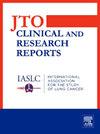1999年至2020年美国间皮瘤死亡率趋势
IF 3.5
Q2 ONCOLOGY
引用次数: 0
摘要
间皮瘤是一种罕见但侵袭性的癌症,主要由接触石棉引起。2024年3月,美国环境保护局禁止在美国使用石棉,但它的使用将需要数年时间才能逐步淘汰。因此,石棉仍然是一种威胁,由于接触到诊断之间的较长潜伏期,发病率可能保持稳定或缓慢下降。本研究调查了1999年至2020年美国间皮瘤死亡率趋势,重点关注人口统计学和地理差异。方法从美国疾病控制与预防中心数据库中提取1999年至2020年间皮瘤相关死亡数据。评估变量包括种族/民族、性别、地理密度和间皮瘤亚型。计算了每100万人的年龄调整死亡率,并将其标准化为2000年美国人口。结合点回归确定了随时间死亡率趋势的统计学显著变化。结果1999年至2020年,美国有54,905例间皮瘤相关死亡(年龄调整死亡率= 7.5)。胸膜间皮瘤占死亡人数的8.1%,腹膜占4.6%,心包占0.01%,其他部位占10.9%,未明确部位占76.3%。大多数死亡(81.3%)发生在65岁以上的个体中。总体死亡率从1999年的8.5下降到2020年的5.7,年死亡率为- 1.9%。非西班牙裔白人的死亡率最高,男性的死亡率高于女性。郊区和农村人口的死亡率最高。结论:该研究强调了1999年至2020年美国间皮瘤死亡率的显著下降,不同人口和地理群体存在差异。为了消除差异,进一步降低间皮瘤死亡率,需要持续监测和有针对性的干预措施。本文章由计算机程序翻译,如有差异,请以英文原文为准。
Trends in Mesothelioma Mortality in the United States Between 1999 and 2020
Introduction
Mesothelioma is a rare but aggressive cancer primarily caused by asbestos exposure. In March 2024, the Environmental Protection Agency banned asbestos in the United States, but its use will take years to phase out. Therefore, asbestos remains a threat, and incidence may remain stable or slowly decrease due to the long latency between exposure and diagnosis. This study investigates mesothelioma mortality trends in the United States from 1999 to 2020, focusing on demographic and geographic variations.
Methods
Data on mesothelioma-related deaths from 1999 to 2020 were extracted from the Centers for Disease Control and Prevention database. Variables including race/ethnicity, sex, geographic density, and mesothelioma subtype were assessed. Age-adjusted mortality rates were calculated per 1 million individuals and standardized to the 2000 United States population. Joinpoint regression identified statistically significant changes in mortality trends over time.
Results
From 1999 to 2020, there were 54,905 mesothelioma-related deaths in the United States (age-adjusted mortality rate = 7.5). Pleural mesothelioma accounted for 8.1% of deaths, peritoneal for 4.6%, pericardial for 0.01%, other sites for 10.9%, and unspecified sites for 76.3%. Most deaths (81.3%) occurred in individuals aged over 65 years. Overall mortality decreased from 8.5 in 1999 to 5.7 in 2020 at −1.9% annually. Non-Hispanic Whites had the highest mortality, and male individuals experienced higher mortality than female individuals. Suburban and rural populations had the highest mortality rates.
Conclusions
The study highlights significant declines in mesothelioma mortality in the United States from 1999 to 2020, with variations across demographic and geographic groups. Continued monitoring and targeted interventions are necessary to address disparities and further reduce mesothelioma mortality.
求助全文
通过发布文献求助,成功后即可免费获取论文全文。
去求助
来源期刊

JTO Clinical and Research Reports
Medicine-Oncology
CiteScore
4.20
自引率
0.00%
发文量
145
审稿时长
19 weeks
 求助内容:
求助内容: 应助结果提醒方式:
应助结果提醒方式:


